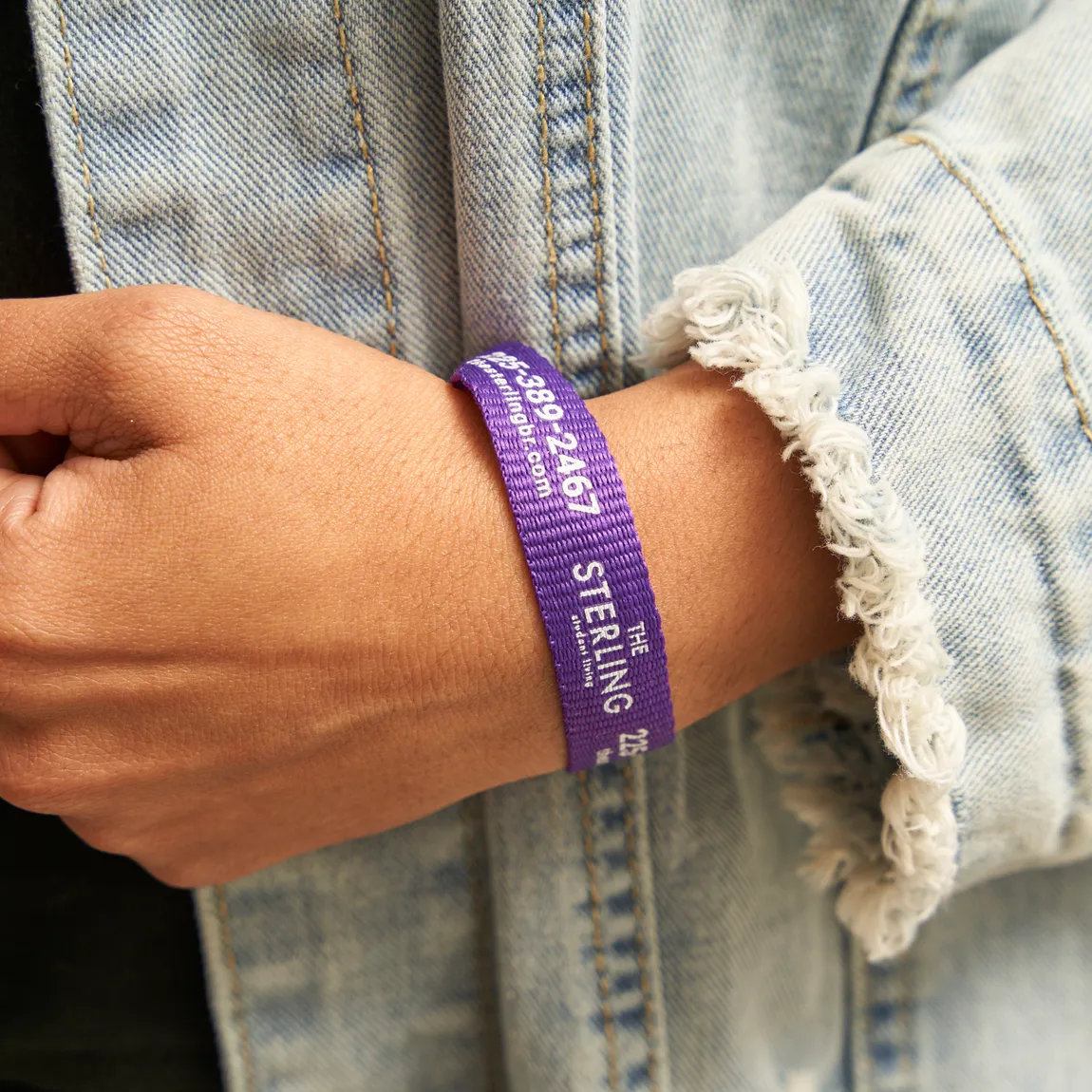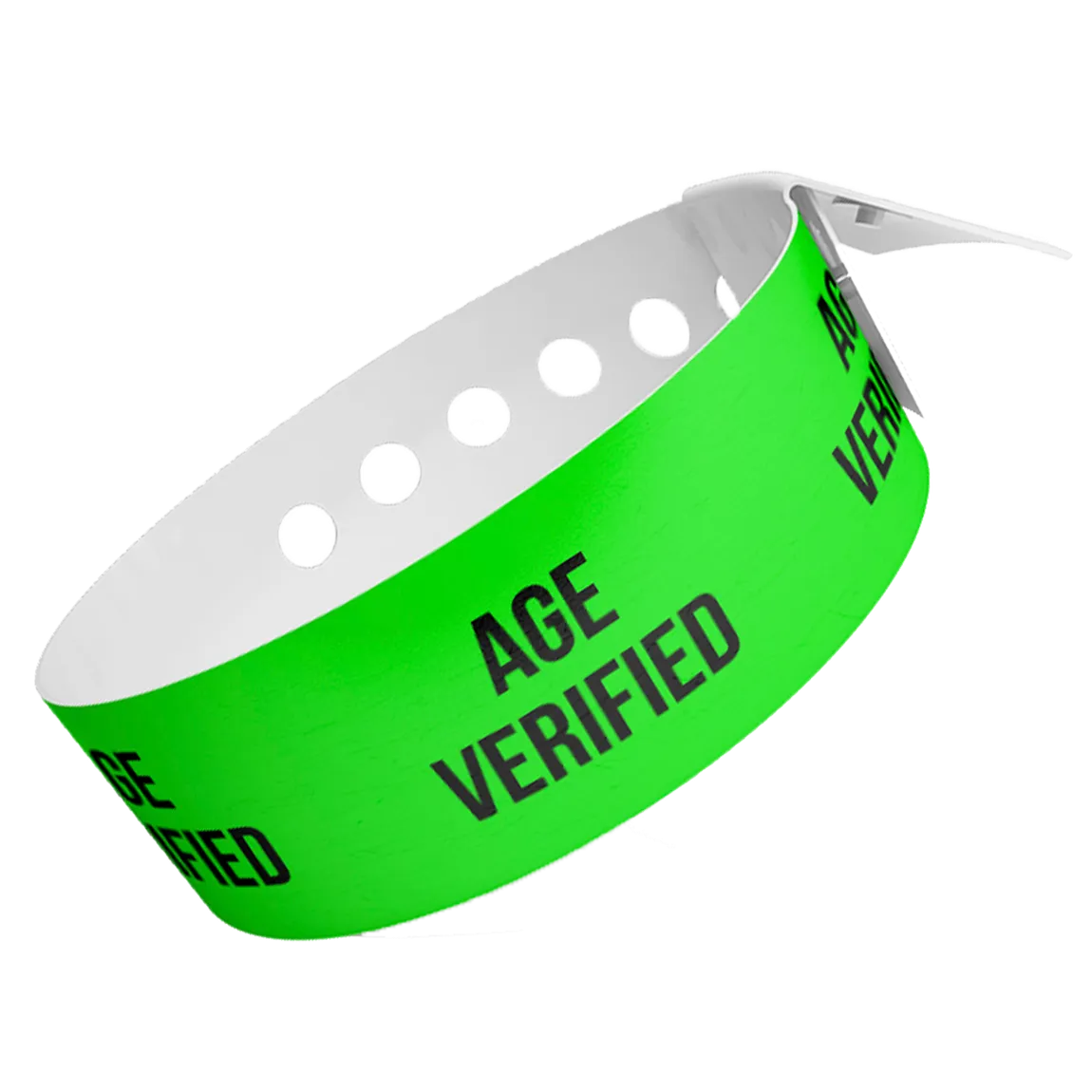
Wristbands are vital for crowd control, branding, attendee engagement, and personal identification in event management. Among the most popular types are cloth and plastic wristbands, each offering distinct advantages and characteristics to suit different event needs.
While printed cloth wristbands are often favored for their durability and comfort, plastic ones (such as vinyl wristbands) are renowned for their cost-effectiveness, versatility, and resistance to environmental conditions. Understanding the key differences can help event organizers make informed decisions when choosing between cloth wristbands and vinyl wristbands made of three layers of durable plastic material.
In this comprehensive guide, we’ll explore the distinct features of both wristband types, compare their performance in various settings, and touch on factors like durability, comfort, weather resistance, cost, environmental impact, and unique practical applications.
Key Uses for Wristbands in Events
Before diving into a detailed comparison, let’s first acknowledge the purpose and functions of wristbands at events. For event organizers, wristbands are more than just stylish accessories. They are practical tools used for:
- Access Control: Granting different levels of access to various areas within the event venue (e.g., VIP areas, staff-only zones).
- Identification: Helping with attendee identification (e.g., at conferences or multi-day festivals) and serving as verification for event participation.
- Branding and Marketing: A creative canvas for adding logos, event names, or sponsor branding as part of merchandise or giveaways.
- Security: Preventing unauthorized entry through tamper-proof features, including RFID technology for digital scanning and data tracking.
Considering these uses, choosing between cloth and plastic wristbands can significantly affect your event's functionality and attendee experience.
|
Pro Tip: Want to enhance your branding strategy? Add sponsor logos or create an interactive social media challenge by embedding QR codes into the wristbands for post-event engagement and to create lasting souvenirs. |
Which Wristband Lasts Longer?
The durability of an event wristband is one of the most critical factors, especially for extended use. Whether you're organizing a weekend-long festival, a medical conference, or a seasonal attraction, understanding how durable a wristband needs to be is essential.
Cloth Wristbands are Built for Strength and Longevity
Cloth wristbands are typically made from woven or printed fabric—usually polyester, cotton, or nylon. These stretch-resistant materials are well known for their strength, flexibility, and resistance to wear and tear, making them well-suited for multiple days where they must withstand constant usage.
- Tensile Strength: The woven fabrics provide high tensile strength and are tear-resistant, making these wristbands resistant to stretching or tearing under pressure. The cloth’s flexibility helps these wristbands withstand frequent movement, making them ideal for prolonged wear at indoor and outdoor events like music festivals, marathons, or gatherings.
- Water Resistance: While cloth wristbands can be water-resistant, especially when treated with protective coatings, they’re not completely waterproof. This means they can endure a moderate amount of sweat or rain, but prolonged exposure to moisture may lead to degradation over time, particularly if not properly maintained. Events hosted at water parks or near beaches may want to avoid fabric options.
|
Pro Tip: When using printed cloth wristbands for events expected to be exposed to humid or wet conditions, consider opting for materials designed with extra water-resistant properties, such as polyester blends. |
Plastic Wristbands are Hard-Wearing and Practical
Plastic, often made from vinyl, polyethylene, or silicone wristbands, is typically more robust when tolerating environmental conditions. They also provide excellent protection against moisture, making them ideal for water parks or adverse weather.
- Waterproof: One of the most significant strengths of plastic wristbands is their complete water resistance. Whether your event occurs during rainy weather, by the pool, or in theme parks with water rides, plastic wristbands stay intact.
- Resistance to Sunlight: Plastic wristbands are less likely to fade or discolor when exposed to prolonged sunlight than printed cloth wristbands. Plastic options are better suited for outdoor events where attendees will spend much time in direct sunlight, such as beach parties or summer fairs.
However, plastic wristbands may still break if subjected to sharp objects or under extreme physical stress. Additionally, cheaper plastic materials may become prone to cracking or warping over time, particularly in cold temperatures.
Does Flexibility Matter?
When selecting wristbands, comfort should also be a primary consideration. Different materials offer distinct levels of comfort, which can greatly impact your attendees’ overall experience, especially at indoor or multi-day events.
Cloth Wristbands are Soft and Custom Fit
Cloth wristbands are generally favored for longer wear because of their soft fabric texture. Sometimes, cloth wristbands are made with a satin finish.
Woven cloth wristbands naturally conform to the wrist and allow breathability, which minimizes skin irritation. Cloth wristbands, particularly those made from softer materials like cotton or polyester with a satin finish, are much more comfortable for long periods.
They are also flexible and less restrictive than plastic options, making them a preferred choice for guests at events where attendees wear them for days, such as multi-day festivals, sports tournaments, or retreats.
Plastic Wristbands are Functional But Less Comfortable
While durable and ideal for specific venues, plastic wristbands tend to be less comfortable for long-term wear due to their rigid nature. Their non-breathable material can trap sweat under hot and humid weather conditions, leading to discomfort and potential skin irritation. These wristbands can suffice for single-day events, but longer events demand more comfort.
Plastic wristbands are an excellent choice for shorter events, such as conferences, amusement parks, or sporting events, where attendees don’t need to wear them for extended periods. The ease of applying and removing plastic wristbands enhances their practicality, but comfort certainly decreases when worn for extended periods—especially if the weather is hot or humid.
How Budget-Friendly Are These Wristbands?
Budget is often a deciding factor for customers and event organizers, especially when managing large stock for extended use where hundreds or thousands of wristbands are required. You want to get the best value for your money without sacrificing quality.
Cloth Wristbands are Costly But Have More Value
Given the production processes involved, cloth wristbands are generally more expensive than plastic wristbands, especially if you opt for custom-woven or intricately designed ones. Event organizers often factor in the higher production costs and the premium aesthetic appeal these wristbands offer.
However, while cloth wristbands are costly, they offer a long-lasting lifespan and can even serve as souvenirs, creating a sense of exclusivity for guests. Many events pass on the additional cost of investing in these wristbands to VIP attendees or as part of premium merchandise.
Plastic Wristbands are Budget-Friendly
If cost efficiency is a priority, plastic wristbands are a slightly cheaper and more affordable choice for event organizers. They are often mass-produced, keeping overall manufacturing costs low.
Due to their low cost per unit, plastic wristbands are the most practical choice in large-scale settings, such as conventions, theme parks, or one-day concerts. While plastic wristbands are useful for short-term events, they are less reusable than cloth wristbands, meaning that new wristbands may always be necessary for repeated events.
Quick Comparison
- Cloth Wristbands: Higher upfront cost, but gives premium feel and longer wear.
- Plastic Wristbands: Lower initial investment, ideal for mass usage or single-use events.
|
Pro Tip: Planning a major festival? Use cloth wristbands for your VIP tickets or premium attendees to create an exclusive feel, while using plastic wristbands for general admission to maximize budget efficiency. |
How Do They Perform in Different Environments?
When planning an outdoor event, wristbands' resistance to different weather conditions—from water to sunlight to changing temperatures—becomes an important consideration.
|
Weather Condition |
Cloth Wristbands |
Plastic Wristbands |
|
Water Resistance |
Moderate (Resistant, but not waterproof) |
High (100% waterproof) |
|
UV Resistance |
Low to Moderate (Fades under sunlight) |
High (Resistant to fading) |
|
Cold Temperature |
May stiffen slightly |
Remains stable |
|
Hot Temperature |
May become pliable or soak sweat |
Stable, may cause skin irritation |
Cloth wristbands fare moderately well in hot and cold temperatures, though their performance in direct sunlight or excessive moisture can decrease over time. UV exposure may cause cloth wristbands to fade, especially with cheaper textiles.
However, if water resistance is critical, cloth wristbands are generally not fully waterproof and may struggle in events near water, such as pool parties or aquatic events.
Plastic wristbands, by contrast, are waterproof and UV-resistant, making them the most weather-proof option for outdoor or aquatic settings. Plastic wristbands won't degrade quickly if exposed to harsh rains, long hours of sunlight, or high humidity. They remain stable in temperature variations, though they are still prone to cracking under stress or continual bending.
Choose the Right Wristband for Your Event
Cloth and plastic wristbands have distinct characteristics that make them suitable for different applications. The two choices depend on event type, duration, security requirements, and environmental considerations.
Both types can be customized and integrated with technology, though they differ in cost, ease of application, and environmental impact. Understanding these key differences allows event organizers and businesses to select the most appropriate wristband type for their needs.
Ready to make the right choice for your event? Explore our wide selection of high-quality wristbands today, and secure your custom wristbands now!


